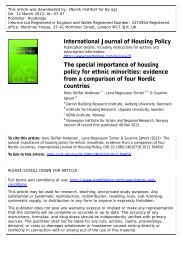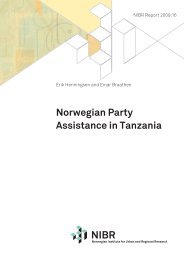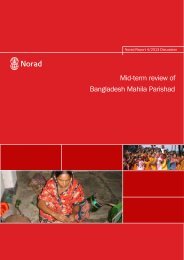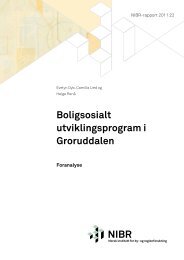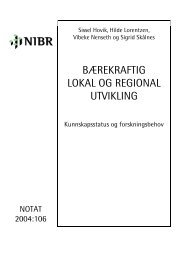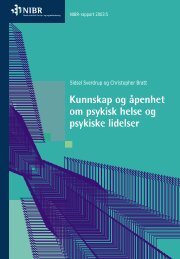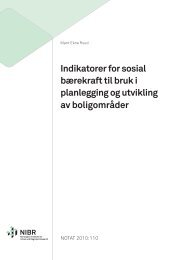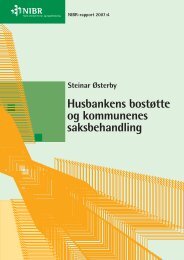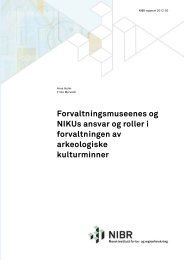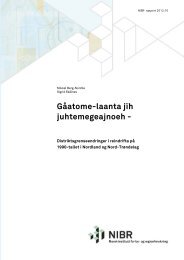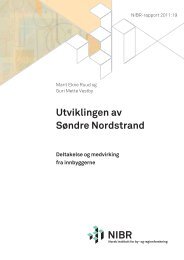Evaluation of the Southern and Eastern Africa Regional Centre for ...
Evaluation of the Southern and Eastern Africa Regional Centre for ...
Evaluation of the Southern and Eastern Africa Regional Centre for ...
- No tags were found...
Create successful ePaper yourself
Turn your PDF publications into a flip-book with our unique Google optimized e-Paper software.
24percent in 2008, 18 percent in 2006, <strong>and</strong> 14 percent in 2004. The distribution <strong>of</strong>gender in responding to <strong>the</strong> survey also approximates <strong>the</strong> 181. As <strong>the</strong> centre has hadstudents from <strong>the</strong> entire region, <strong>the</strong> survey was sent out to students from severalcountries. The distribution <strong>of</strong> nationalities that responded closely corresponds to anoverall total <strong>of</strong> 38 percent <strong>of</strong> (181) graduates being Zimbabwean. When it comes to<strong>the</strong> distribution across age cohorts, more respondents were between 25-35 than anyo<strong>the</strong>r group, but a fair amount was also younger (35-45 years old) <strong>and</strong> older (45-55years) <strong>and</strong> over 55. Moreover, as students have had diverse backgrounds, we hadthree questions in <strong>the</strong> survey to retrieve in<strong>for</strong>mation about <strong>the</strong>ir background. Onequestion was whe<strong>the</strong>r <strong>the</strong>y were lawyers or non-lawyers. We <strong>the</strong>n asked <strong>the</strong> lawyersto specify <strong>the</strong>ir sub-discipline/type <strong>of</strong> law in an open text box. The non-lawyers wereasked to specify what discipline <strong>the</strong>y have as <strong>the</strong>ir educational background. It appearsthat slightly more non-lawyers replied than lawyers (Annex 4 shows overall breakdown should be 79 percent <strong>and</strong> 21 percent respectively).We <strong>the</strong>n turned to ask whe<strong>the</strong>r <strong>the</strong>ir previous <strong>and</strong> present work was related towomen’s rights, with <strong>the</strong> alternatives <strong>of</strong> ‘directly’, ‘indirectly’, ‘not related’ or ‘do notknow’ as response categories. 67 percent responded that <strong>the</strong>ir previous work wasrelated to women’s rights, while 66 percent responded that <strong>the</strong>ir present work isrelated to it as well. The same percentage <strong>of</strong> respondents- 32 percent- said that <strong>the</strong>irprevious <strong>and</strong> present work is not related to women’s rights.To reiterate <strong>the</strong> survey corresponds well to <strong>the</strong> overall graduate cohort. However, inaddition, concerning students with disabilities, we are aware that at least two hadvisual impairments. Though <strong>the</strong>re is not a policy or quota <strong>for</strong> such students, we areaware that SEARCWL made extensive provisions <strong>for</strong> those disabled students whohave attended <strong>the</strong> course.3.2 Overall Survey Findings on Masters CourseThe survey contained some questions regarding <strong>the</strong> course. One question was why<strong>the</strong> graduates chose <strong>the</strong> course in Zimbabwe. Four options were listed: “reputation<strong>of</strong> SEARCWL”, “bursary” (i.e. scholarship), “employment prospects”, “location”,“<strong>the</strong> regional nature <strong>of</strong> <strong>the</strong> course”, “o<strong>the</strong>r, please specify”. The responses show thatpeople did <strong>the</strong> course <strong>for</strong> a variety <strong>of</strong> reasons, with no outst<strong>and</strong>ing factor. However,<strong>the</strong> focus group in Zimbabwe <strong>and</strong> some interviews suggested that several had chosen<strong>the</strong> course because <strong>of</strong> <strong>the</strong> scholarship; that <strong>the</strong>y had taken <strong>the</strong> undergraduate coursein Women’s Law at <strong>the</strong> University <strong>of</strong> Zimbabwe; <strong>and</strong> <strong>for</strong> some women <strong>the</strong> flexibilityallowed <strong>for</strong> mo<strong>the</strong>rs with young children.In addition, <strong>the</strong> graduates were asked to grade <strong>the</strong>ir satisfaction with <strong>the</strong> course from1 to 5 (where 5 is <strong>the</strong> highest) which has been summarised as follows:



